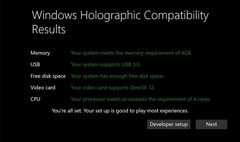Virtual Reality may be the next big thing in computer technology. HTC’s Vive and the Oculus Rift have certainly made waves, but Microsoft will soon enter the game with the upcoming Windows 10 Creators Update. In order to support the more affordable VR headsets coming next year, Microsoft will develop their own VR platform, Windows Holographic. Thanks to an app that tests compatibility with Windows Holographic (dubbed “Windows Holographic First Run”), the minimum system requirements for the software have been released.
Tom Warren of the Verge has tested multiple systems, and it appears that the minimum required specs are fairly low end. Users will need at least 4 GB of RAM, USB 3.0, a graphics card with DirectX 12 support, and either a quad-core or hyperthreaded dual-core CPU.
In contrast, both the Vive or Rift require high-end components, including top-tier graphics cards and powerful CPUs. Machines that can adequately support the Vive and the Rift are typically enthusiast-class rigs that can be prohibitively expensive. Windows Holographic looks much less demanding and may run on much more affordable PC setups. This should pair well with the aforementioned VR headsets for Windows 10, which will start at about $300.
Microsoft is expected to release Windows Holographic early next year with VR headsets from third parties going on sale around that time.





